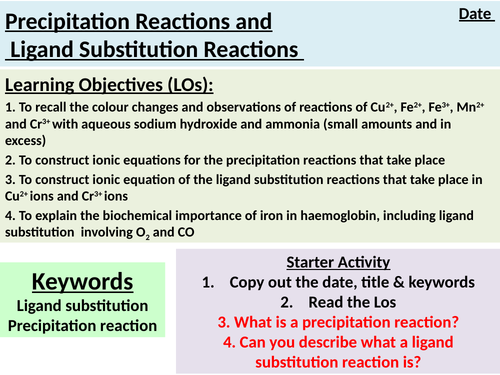

A structured KS5 lesson including starter activity and AfL work tasks and main work tasks on Precipitation & Ligand Substitution Reactions. All tasks have worked out answers, which will allow students to self assess their work during the lesson
**
By the end of this lesson KS5 students should be able to:
LO1: To recall the colour changes and observations of reactions of Cu2+, Fe2+, Fe3+, Mn2+ and Cr3+ with aqueous sodium hydroxide and ammonia (small amounts and in excess)
LO2: To construct ionic equations for the precipitation reactions that take place
LO3: To construct ionic equation of the ligand substitution reactions that take place in Cu2+ ions and Cr3+ ions
LO4: To explain the biochemical importance of iron in haemoglobin, including ligand substitution involving O2 and CO**
**Note: This lesson includes 15 ligand substitution & precipitation reactions students need to remember- students are advised to create flashcards for these reactions (this can be completed as a flip learning homework task). Creation of flashcards should be followed up with a practical lesson on precipitation and ligand substitution reactions- see my TES shop for this practical lesson **
Alternatively: To save students time you can buy this resource with includes 23 printable flashcards of all the transition element reactions: precipitation, ligand substitution and redox reactions (click below for this resource):
https://www.tes.com/teaching-resource/resource-12637622
Declaimer: Please refrain from purchasing this popular resource for an interview lesson or a formal observation. This is because planning your own lessons, including using your own lesson PowerPoints, is a fundamental skill of a qualified/unqualified teacher that will be assessed during the scenarios outlined above
Something went wrong, please try again later.
This resource hasn't been reviewed yet
To ensure quality for our reviews, only customers who have purchased this resource can review it
Report this resourceto let us know if it violates our terms and conditions.
Our customer service team will review your report and will be in touch.